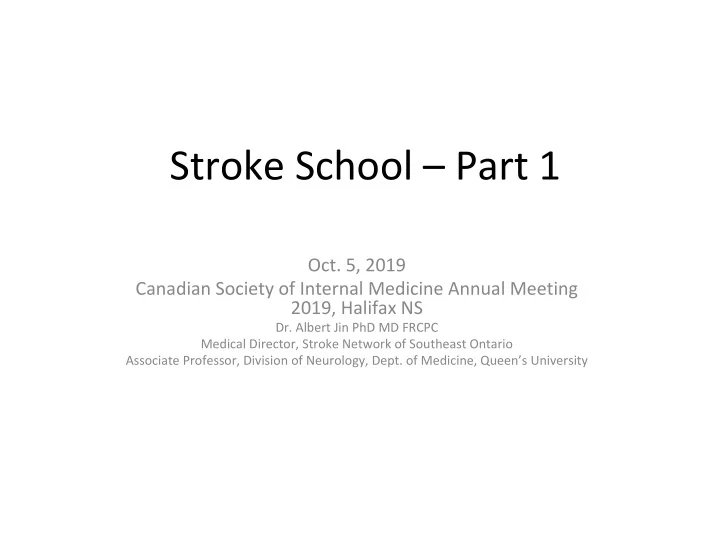

Lacunar stroke syndromes • Ataxic hemiparesis often arises from infarction in the corona radiata • Ataxia is unilateral and is in excess of the mild weakness found on exam
Lacunar stroke syndromes • Clumsy hand-dysarthria is caused by infarction in the pons, but can also occur in corona radiata and the internal capsule • Contralateral facial weakness with dysarthria and dysphagia occurs with contralateral hand weakness/ataxia, and sometimes weakness in the arm or leg
Summary • MCA stroke: hemiparesis, sensory loss, hemianopia, and either aphasia or neglect • ACA stroke: leg weakness and executive dysfunction • PCA stroke: hemianopia, pure sensory infarct (thalamus), memory impairment, decreased level of consciousness • Brainstem strokes: crossed sensory or motor findings, nystagmus, ataxia, dysarthria, diplopia, vertigo, Horner’s syndrome • Cerebellar strokes: ataxia, nystagmus, vertigo, nausea, headache and rapid deterioration in consciousness • Lacunar strokes: pure motor, pure sensory, sensorimotor, ataxic hemiparesis, clumsy hand-dysarthria
3. How to read a CT scan
We will learn the following: • Recognize basic anatomical structures on a plain CT head • Recognize acute thrombus in the MCA • Recognize acute ischemic stroke • Recognize acute intracranial hemorrhage
Reading a plain CT head • Know the following levels on an axial CT: – Medulla, Cerebellum, and Vertebral Arteries – Pons, and Basilar Artery – Midbrain, and Proximal Middle Cerebral Arteries – Basal ganglia and Insula – Corona radiata – Centrum semiovale
Reading a plain CT head Medulla • It helps to know where you are in the brain when scrolling through a plain CT head: – Medulla and Cerebellum – Pons – Midbrain – Basal ganglia – Corona radiata Left – Centrum semiovale vertebral artery Cerebellum
Pons Basilar artery
Midbrain Middle cerebral artery
Basal ganglia: Caudate and Lentiform Nuclei Insula Thalamus
Corona radiata
Centrum semiovale Central sulcus
Recognize acute thrombus • As you review the following slides, recall that the Midbrain level is where you see the proximal MCA (and distal ICA)
Detecting early cerebral ischemia on CT scan • Loss of grey-white differentiation – You may have to adjust the brightness and contrast (the “window width” and “window level”) • Loss of sulci • Use the same system every time you look at a CT for possible acute stroke – For example, the Alberta Stroke Program Early CT Score (ASPECTS)
Alberta Stroke Program Early CT Score M4 M1 C I L M2 M5 IC M3 M6 C = caudate, L = lentiform, I = insula, IC = internal capsule M1, M2, M3 = anterior, lateral, posterior MCA territory; M4 to M6 are above the lentiform nuclei
Right hemiparesis and aphasia: Where is the infarct?
Can you see the infarct using ASPECTS? I M2 M5
Case • 77 year old female with left hemiparesis, left homonymous hemianopia, left side sensory loss
Recommend
More recommend